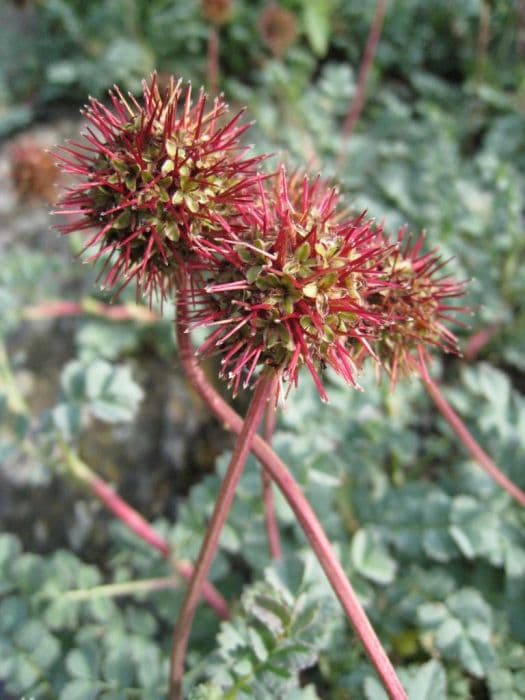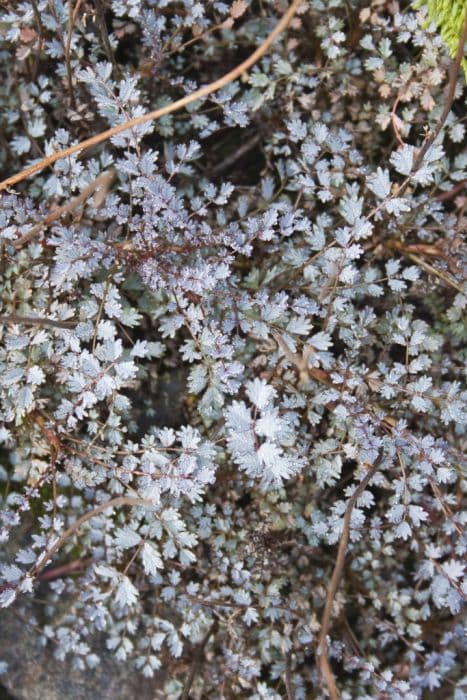Climbing Rose Rosa cymosa

ABOUT
Rosa cymosa, commonly known as the Chinese climbing rose, is a flowering plant that showcases a delightful and ornate appearance. It features a climbing or trailing habit with stems that are equipped with sharp thorns. The leaves are typically bright green, exuding a fresh and lush aura, and they are divided into several smaller, oval-shaped leaflets with a somewhat serrated edge. The most captivating aspect of the Chinese climbing rose is its blossoms. The flowers are typically arranged in clusters, forming a stunning floral display. Each flower is beautifully crafted with numerous petals that can range from white to various shades of pink, offering an enchanting sight when in full bloom. These petals are soft and velvety to the touch, adding a tactile dimension to the plant's charm. At the center of each flower lies a cluster of prominent stamens, which often attract pollinators such as bees and butterflies. Additionally, the blooms emit a subtle yet pleasant fragrance, enhancing the sensory appeal of the plant. After the flowering season, the plant may produce ornamental fruit, often referred to as hips, which can add further interest to its appearance. The Chinese climbing rose is appreciated for its decorative qualities, making it a popular choice for garden trellises and arches.
About this plant
 Names
NamesSynonyms
Climbing Rose, Chinese Climbing Rose, Evergreen Rose
Common names
Rosa cymosa Tratt.
 Toxicity
ToxicityTo humans
Rosa cymosa, commonly known as climbing rose, generally is not considered toxic to humans. While the plant itself is not poisonous, care should be taken as the thorns can cause physical injury if handled improperly. If ingested, parts of the plant are unlikely to cause serious poisoning, but it may cause mild gastrointestinal discomfort in some individuals. It is always advisable to avoid ingesting any part of ornamental plants due to the potential for mild stomach upset.
To pets
Climbing rose, or Rosa cymosa, is not known to be toxic to pets such as dogs and cats. The plant does not contain substances that are considered poisonous to pets. However, similar to humans, pets could experience mild gastrointestinal upset if they ingest parts of the plant. The thorns can also cause physical injuries like scratches or punctures. It is recommended to keep pets from chewing on plants, even non-toxic ones, to prevent any potential discomfort or injury.
 Characteristics
CharacteristicsLife cycle
Perennials
Foliage type
Deciduous
Color of leaves
Green
Flower color
White
Height
3-4 feet (0.9-1.2 meters)
Spread
3 feet (0.9 meters)
Plant type
Shrub
Hardiness zones
9
Native area
China
Benefits
 General Benefits
General Benefits- Aesthetic Appeal: Rosa cymosa, commonly known as the East Asian climbing rose, is known for its beautiful flowers which enhance the visual appeal of gardens and landscapes.
- Habitat for Wildlife: The plant provides a habitat for various forms of wildlife, including bees, butterflies, and birds, which can pollinate other plants in the area.
- Shade and Shelter: Its growth habit and dense foliage offer shade and shelter for smaller plants and organisms in the garden.
- Erosion Control: The root system of Rosa cymosa helps to stabilize the soil, reducing erosion in sloped or vulnerable areas.
- Fragrance: The flowers of the East Asian climbing rose emit a pleasant fragrance that contributes to a sensory garden experience.
- Cultural Significance: In some cultures, Rosa cymosa is used for traditional ceremonies and is valued for its symbolic meanings of love and beauty.
- Garden Design: It serves as an excellent addition to garden designs, particularly for creating natural archways and focal points due to its climbing nature.
 Medical Properties
Medical Properties- Anti-inflammatory: Rosa cymosa may possess compounds that help to reduce inflammation in the body.
- Antioxidant: Containing natural antioxidants, it can contribute to neutralizing harmful free radicals.
- Antimicrobial: Some studies suggest the existence of antimicrobial properties, potentially inhibiting the growth of certain bacteria and fungi.
- Skin health: Its extracts might be used in skin care products for its potential soothing effects on the skin.
- Wound healing: There could be compounds in Rosa cymosa that promote the healing of wounds.
 Air-purifying Qualities
Air-purifying QualitiesThis plant is not specifically known for air purifying qualities.
 Other Uses
Other Uses- Rosa cymosa, also known as climbing rose, can be trained to cover fences and arbors, providing an aesthetic natural privacy screen.
- The plant's hips (fruit of the rose) can be used to make a vitamin-rich tea, which is high in vitamin C and antioxidants, though not intended as medical advice.
- Climbing rose blooms can be pressed or dried for use in crafts such as making potpourri, floral arrangements, or natural confetti.
- The wood from mature Rosa cymosa can be carved into small ornamental objects or used in the creation of durable walking sticks.
- They can be used in landscape design to create a focal point or center of attention in gardens due to their vigorous growth and vibrant flowers.
- Essential oils derived from the flowers can be used in perfumery and aromatherapy for their characteristic scent.
- Climbing rose thorns can be used as natural grafting splices to join two plants together in the process of propagation.
- The petals of Rosa cymosa can be used as a natural dye for fabrics, offering shades of pink and light red depending on the mordant used.
- These roses can be utilized for educational purposes such as studying botany, particularly the plant’s reproductive system and climber behavior.
- Large Rosa cymosa bushes can act as a deterrent to unwanted wildlife due to their dense growth and thorny branches.
Interesting Facts
 Feng Shui
Feng ShuiThe Rosa cymosa is not used in Feng Shui practice.
 Zodiac Sign Compitability
Zodiac Sign CompitabilityThe Rosa cymosa is not used in astrology practice.
 Plant Symbolism
Plant Symbolism- Love: As with many roses, Rosa cymosa often symbolizes love and affection due to its beautiful flowers and association with the timeless nature of love.
- Beauty: The aesthetic appeal of the rose's blooms lends itself to symbolize beauty and grace.
- Purity: The rose can be symbolic of purity, especially if the flowers are white, representing innocence and chasteness.
- Secrets or Confidentiality: Roses have historically been symbols of confidentiality; the term 'sub rosa' (under the rose) indicates secrecy or confidentiality.
- Passion: The intense color of its flowers can signify deep passion and strong emotions.
- Balance: The harmonious and symmetrical form of this rose might represent balance and new beginnings, similar to other roses.
 Water
WaterFor Rosa cymosa, commonly known as the climbing rose, it's essential to maintain consistent soil moisture but avoid overwatering. Water deeply once a week, providing about 1-2 gallons of water for each plant, ensuring you're reaching the roots rather than just wetting the surface. During hot, dry spells, check the moisture level of the soil more frequently and water accordingly, possibly increasing to two times per week. In cooler or rainy periods, reduce the frequency to prevent waterlogging. Always water early in the morning to allow the foliage to dry before nightfall, which reduces the risk of disease.
 Light
LightClimbing roses like Rosa cymosa thrive best in a location that receives full sun for at least six hours a day. They will perform optimally when planted where they can bask in the morning sun, which helps dry the dew on the leaves, reducing the likelihood of fungal diseases. Avoid excessively shaded areas, as too little light can lead to poor flowering and weak growth.
 Temperature
TemperatureClimbing roses prefer a moderate temperature range and are hardy between 35°F and 90°F. Rosa cymosa can endure brief periods outside of this range but for optimal growth, aim for a temperature between 60°F and 70°F. Protect them from extreme cold by applying mulch or using frost covers, and ensure good air circulation to prevent overheating during hot summers.
 Pruning
PruningPruning climbing roses like Rosa cymosa is vital for maintaining plant health, encouraging blooming, and shaping the plant. Prune in late winter or early spring, removing dead or diseased wood and thinning out crowded areas to promote air circulation. Also, cut back spent flowers to encourage repeat blooming throughout the season. The best time to undertake heavy pruning is while the plant is dormant, just before the last frost.
 Cleaning
CleaningAs needed
 Soil
SoilThe best soil mix for Rosa cymosa, commonly known as Climbing Rose, should be rich in organic matter with good drainage capabilities. A mix consisting of two parts loam, one part peat moss or compost, and one part perlite or sand is ideal. The optimal soil pH for Climbing Rose should be between 6.0 and 6.5 for healthy growth.
 Repotting
RepottingClimbing Roses like Rosa cymosa should typically be repotted every two to three years to refresh the soil and accommodate their growing root systems. However, mature plants may be repotted less frequently if they are pruned appropriately and not showing signs of being root-bound.
 Humidity & Misting
Humidity & MistingClimbing Rose plants such as Rosa cymosa prefer average humidity levels. They thrive best when the humidity is around 40 to 60 percent. Maintaining this level will support the plant's health without additional humidity controls.
 Suitable locations
Suitable locationsIndoor
Ensure ample light and prune regularly.
Outdoor
Needs full sun, well-drained soil, and space to climb.
Hardiness zone
5-9 USDA
 Life cycle
Life cycleRosa cymosa, commonly known as climbing rose, begins its life cycle when seeds germinate in suitable soil conditions, typically in early spring. Seedlings develop into young plants with characteristic pinnate leaves and begin to photosynthesize. As the rose matures, it undergoes vegetative growth, developing sturdy stems and a robust root system. In due time, usually during late spring to early summer depending on the climate, the climbing rose progresses to the flowering stage, producing fragrant blooms that may range in color. After pollination by insects or other means, these flowers will produce hips, which are the fruiting bodies containing seeds for the next generation. As the growing season ends, the climbing rose enters a period of dormancy, especially in regions with colder winters, where it conserves energy before re-emerging in the subsequent growth cycle.
 Propogation
PropogationPropogation time
Spring-summer
Propogation: The most popular method for propagating Rosa cymosa, commonly known as the Climbing Rose, is through semi-hardwood cuttings. Semi-hardwood cuttings are best taken during the late summer. To do this, a cutting of about 6 to 8 inches (15 to 20 centimeters) long with several leaf nodes is selected. Leaves on the lower half of the cutting are removed, and the base of the cutting is dipped in rooting hormone to encourage root development. The cutting is then planted in a pot filled with a well-draining soil mix, ensuring at least two or three nodes are buried. The environment should be kept humid and the soil consistently moist to help the cutting take root. Roots generally begin to form within a few weeks, after which the plant can eventually be transferred outside or to a larger container.









